
How To Play A Counterblow
The ability to recover after a tactical oversight is a difficult skill to master. Indeed, the temptation to panic after blundering an ostensibly crushing sacrifice or combination is overwhelming. It is the mark of a strong, experienced player to remain cold-blooded and rational no matter the circumstance.
Sometimes, a tactical blow is much less threatening than it appears, and succeeds only because of its psychological potency. The refutation (i.e. the counterblow) might be straightforward, but -- put simply -- you will not be able to find it unless you are thinking straight!
The following obscure game is an excellent illustration.
Tishin's double-rook sacrifice was gorgeous, but it should have remained behind the scenes. Tukhaev, who had dominated for the entire game, was unable to recover from the emotional shock, and failed to realize that 28...Rxg3 does not actually pose any threats.

Of course, the counterblow might be rather difficult to spot, but the process of elimination is an invaluable tool.
An astounding finale! Gelfand was able to neutralize the onslaught on two separate occasions, with a kamikaze rook sacrifice and later with a subtle intermezzo. However, in the position after 21.Qxf6, Black was literally forced to make the right moves.

A counterblow does not have to be a spectacular move. A subtle defensive idea is just as much of a counterblow as a brilliant sacrifice. In one of my recent games, my opponent found an awesome maneuver to pulverize my attack.
Not all tactical blows are created equal. Some are indeed decisive, but others look far more intimidating than they actually are.
Always be on the lookout for a counterblow!
RELATED STUDY MATERIAL
- Read GM Naroditsky's last article: The Two-Knight Advantage.
- Watch GM Melikset Khachiyan's video on the counterattack.
- Take a lesson on counterattack in the Chess Mentor.
- Practice your tactics in the Tactics Trainer.
- Looking for articles with deeper analysis? Try our magazine: The Master's Bulletin.






